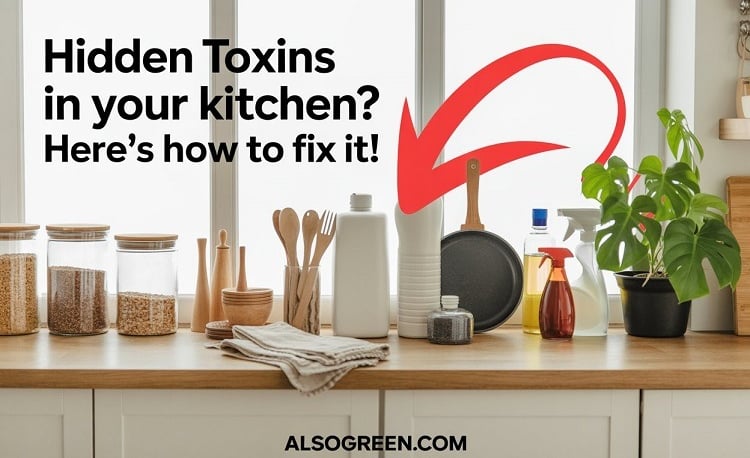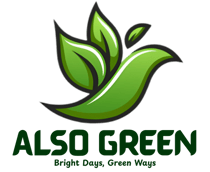Why Your Kitchen Is Full of Hidden Toxins — and 7 Easy Fixes That Work
Is your kitchen silently harming your health? Discover 7 easy, eco-friendly fixes to remove hidden toxins and create a safe, green cooking space.


Why Your Kitchen Is Full of Hidden Toxins — and 7 Easy Fixes That Work
Your kitchen might appear spotless, but beneath the surface, it could harbor harmful toxins that impact your health and the environment. Every day, plastic containers, non-stick cookware, and conventional cleaning products often contain chemicals that can leach into your food or pollute your home.
This guide will uncover familiar sources of kitchen toxins and provide seven practical, affordable, and eco-friendly solutions for creating a safer, greener cooking space.
The Hidden Dangers in Your Kitchen
What Are Kitchen Toxins?
Kitchen toxins are harmful chemicals in household items such as plastic containers, cleaning supplies, non-stick cookware, and food packaging. They can enter our bodies through inhalation, skin contact, or contaminated food.
Why Should You Care?
Studies have linked common kitchen toxins to hormone disruption, respiratory issues, and even long-term health concerns like cancer. They're not just bad for your health—they also harm the environment by polluting water sources and increasing plastic waste.
7 Easy Fixes That Work
1. Replace Plastic Wrap with Beeswax Wraps or Silicone Lids
Plastic wrap is an everyday kitchen staple, but many contain hidden toxins like phthalates and BPA—chemicals known to disrupt hormones and pose long-term health risks. If you're concerned about safety and sustainability, consider switching to natural alternatives to plastic wrap.
Beeswax wraps and reusable silicone lids are excellent options. They're non-toxic, eco-friendly, and reusable, helping you reduce plastic waste while keeping your food fresh.
Fix: Swap out plastic wrap for beeswax wraps or silicone lids. They're washable, long-lasting, and completely free of harmful chemicals.
Recommended Product: Bee's Wrap Reusable Beeswax Food Wraps
2. Switch to Non-Toxic Cookware Like Cast Iron or Ceramic
Many Teflon-coated pans can release toxic fumes when overheated, posing a hidden risk in your kitchen. For an eco-friendly kitchen, a more intelligent choice is switching to non-toxic cookware, such as cast iron or ceramic options. These materials are free from harmful chemicals and incredibly durable, making them both a healthy and sustainable solution for everyday cooking.
Fix: Choose cast iron or ceramic cookware. They're durable and don't leach harmful substances into your food.
Recommended Product: Lodge Cast Iron Skillet
3. Use DIY Cleaners Made from Safe Ingredients
Many common kitchen sprays contain ammonia, bleach, and synthetic fragrances, which can pollute indoor air and irritate skin and lungs.
Fix: Switch to safe kitchen cleaning ingredients like vinegar, lemon, and baking soda. These natural alternatives are as effective and far safer for your home and health.
DIY Tip: Mix 1 cup white vinegar, 1 tablespoon lemon juice, and 1 cup water in a spray bottle for an all-purpose, non-toxic cleaner.
Recommended Product: Mrs. Meyer's Clean Day Multi-Surface Cleaner
4. Ditch Sponges for Eco-Friendly Dish Brushes
Regular kitchen sponges are breeding grounds for bacteria, and many are made from non-biodegradable synthetic materials that end up in landfills.
Fix: Upgrade your sink setup with eco-friendly dishwashing tools like bamboo brushes or compostable loofahs. They're reusable, naturally antimicrobial, and better for your health and the environment.
Recommended Product: LOLA Products Eco Clean Bamboo Dish Brush
5. Store Food in Glass or Stainless Steel Containers
Many plastic containers can leach harmful chemicals like BPA into your food, especially when microwaved or exposed to heat. These toxins are linked to hormone disruption and long-term health concerns.
Fix: Switch to BPA-free food storage solutions such as glass containers or stainless steel tiffins. They're durable, reusable, and safer for storing hot and cold meals.
Recommended Product: H.JSS WDJS 8-Pack Glass Food Storage Containers
6. Choose Unbleached Paper Towels and Napkins
Most conventional paper towels and napkins are bleached with chlorine, releasing harmful dioxins, toxic pollutants that linger in our environment and may impact human health.
Fix: Opt for eco-friendly paper products for the kitchen, such as unbleached, recycled, or reusable cloth alternatives. These options are safer for your family and help reduce your kitchen's environmental footprint.
Recommended Product: Seventh Generation Unbleached Paper Towels
7. Add Air-Purifying Plants to Detox the Air
The kitchen's indoor air can carry toxins from cooking fumes, harsh cleaning products, and food packaging, contributing to poor air quality over time.
Fix: One easy way to detox your kitchen naturally is by adding air-purifying plants like aloe vera, peace lily, or spider plants. These green companions brighten your space, absorb pollutants, and improve indoor air quality.
Recommended Product: Costa Farms Clean Air 3-Pack
Build Healthy Kitchen Habits
Making one swap is excellent, but small steps daily will create a toxin-free kitchen over time.
Tips:
Read product labels carefully
Avoid products with "fragrance" or unknown chemicals
Choose organic and sustainable brands when possible
Checklist:
Replace one plastic item this week
Try a homemade cleaner
Invest in a non-toxic pan
Related Articles You Might Like
Final Thoughts
Your kitchen doesn't need a complete makeover to be toxin-free. By identifying hidden sources of chemicals and making small, smart changes, you can transform your kitchen into a healthier, greener space for your family.
Ready to start detoxing your kitchen today? Tell us in the comments which tip you'll try first, and don't forget to follow us on Pinterest for more sustainable home tips!
Also Green
Embrace a mindful and eco-friendly lifestyle today.
Contact
contact@alsogreen.com
© 2025 Also Green. All Rights Reserved
+14706521930
